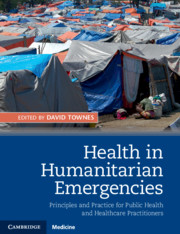 Health in Humanitarian Emergencies
Health in Humanitarian Emergencies Book contents
- Health in Humanitarian Emergencies
- Health in Humanitarian Emergencies
- Copyright page
- Dedication
- Contents
- Contributors
- Foreword
- Abbreviations
- Section 1 Humanitarian Emergencies
- Section II Public Health Principles
- Section III Illness and Injury
- Chapter 21 Acute Respiratory Infection
- Chapter 22 Diarrheal Diseases
- Chapter 23 HIV
- Chapter 24 Malaria
- Chapter 25 Acute Malnutrition
- Chapter 26 Measles
- Chapter 27 Meningococcal Disease
- Chapter 28 Mental Health
- Chapter 29 Tuberculosis
- Chapter 30 Injuries and Trauma
- Chapter 31 Noncommunicable Diseases
- Index
- References
Chapter 30 - Injuries and Trauma
from Section III - Illness and Injury
Published online by Cambridge University Press: 26 July 2018
- Health in Humanitarian Emergencies
- Health in Humanitarian Emergencies
- Copyright page
- Dedication
- Contents
- Contributors
- Foreword
- Abbreviations
- Section 1 Humanitarian Emergencies
- Section II Public Health Principles
- Section III Illness and Injury
- Chapter 21 Acute Respiratory Infection
- Chapter 22 Diarrheal Diseases
- Chapter 23 HIV
- Chapter 24 Malaria
- Chapter 25 Acute Malnutrition
- Chapter 26 Measles
- Chapter 27 Meningococcal Disease
- Chapter 28 Mental Health
- Chapter 29 Tuberculosis
- Chapter 30 Injuries and Trauma
- Chapter 31 Noncommunicable Diseases
- Index
- References
- Type
- Chapter
- Information
- Health in Humanitarian EmergenciesPrinciples and Practice for Public Health and Healthcare Practitioners, pp. 441 - 459Publisher: Cambridge University PressPrint publication year: 2018
References
- 1
- Cited by


